Who Controls the User Experience? AMD’s Carrizo Thoroughly Tested
by Ian Cutress on February 4, 2016 8:00 AM ESTComparing AMD Carrizo to Intel Core
While generational updates are a crucial part of the examination, there has to be comparison with the competition. Intel has an overriding advantage in process node, meaning that performance per watt is difficult to compete against, but also OEMs seem unwilling to use Carrizo in the same device designs as they do with Core either due to partnerships or other issues (e.g. ASUS UX301/UX305 uses 15W Core i5). Nonetheless, Intel’s product line is a sequence of parts that intersect each other, with low end models equipped with dual core Pentiums and Celerons, stretching into some i3 and i5 territory while still south of $1000. In this mix is Core M, Intel’s 4.5W premium dual core parts found in devices north of $600.
| AMD Carrizo vs Intel Core | ||||||||
| SoC | A12-8800B | FX-8800P | i5-5200U | m3-6Y30 | i5-6300U | i7-6600U | ||
| CPU | Carrizo 2M/4T >3.4 GHz |
Carrizo 2M/4T >3.4 GHz |
Broadwell 2C/4T >2.7 GHz |
Skylake 2C/2T >2.2 GHz |
Skylake 2C/4T >3.0 GHz |
Skylake 2C/4T >3.2 GHz |
||
| CPU TDP | 15W | 15W | 15W | 4.5W | 15W | 15W | ||
| GPU | R7 GCN 1.2 512 SPs 800 MHz |
R7 GCN 1.2 512 SPs 800 MHz |
HD 5500 Gen8 24 EUs 900 MHz |
HD 515 Gen9 24 EUs 850 MHz |
HD 520 Gen 9 24 EUs 1 GHz |
HD 520 Gen 9 24 EUs 1.05 GHz |
||
| DRAM | 1x4GB DDR3 1600MHz |
1x8GB DDR3L 1600MHz |
2x8GB DDR3L 1600MHz |
2x4GB DDR3L 1600MHz |
2x4GB DDR3L 1600MHz |
2x8GB LPDDR3 1866MHz |
||
| Storage | 128GB SSD |
750GB HDD |
256GB SSD |
256GB SSD |
256GB SSD |
256GB PCIe |
||
| SoC Price | ~$150 | ~$150 | $281 | $281 | $281 | $393 | ||
As part of this comparison, we took our results from the 15W Carrizo laptops home and put them up against several Intel parts. The main comparison point is the i5-5200U, a 15W Broadwell part from Intel (in this case from the BRIX mini-HTPC I have at home) and the i5-6300U, a 15W Skylake part from the Surface Pro 4. Both Intel parts have a slightly lower frequency than the top-end Carrizo parts, but match Carrizo's 2MB L2 cache while also implementing a 3MB L3 cache, which gives them an advantage in cache-limited scenarios. The Skylake i5, compared to the Broadwell i5, uses a newer architecture and increased frequencies, and both are made on 14nm rather than 28nm, which gives Intel a significant process node (and by extension a perf/watt) advantage.
To add some more interesting points into the mix, we have also pulled in some results from the ASUS UX305, a Skylake-Y based Core M device at 4.5W. Our UX305 uses a lower-end m3-6Y30, but it gives us an idea of how very low power Core fares in comparison to 15W Carrizo. Meanwhile at the opposite end of the spectrum we also have thrown in an i7-6600U system, one of Intel's top 15W SKUs, allowing us to compare the best 15W part from AMD to the best 15W part from Intel. That said, given the current performance realities of the CPU market, it is worth noting here that the these parts are in two different segments to Carrizo based on price/performance and performance/watt ($393 for the i7-6600U alone can be as much as a full Carrizo laptop).
First up, a selection of CPU tests:
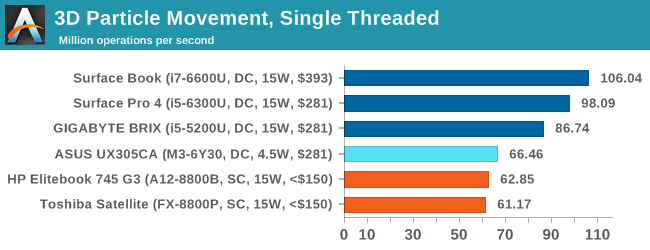
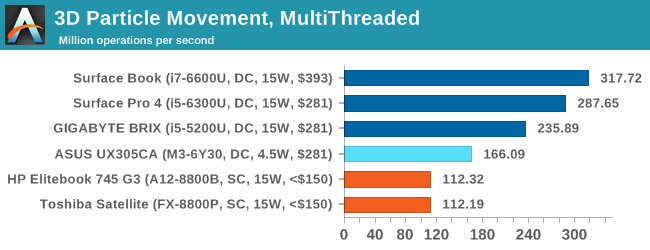
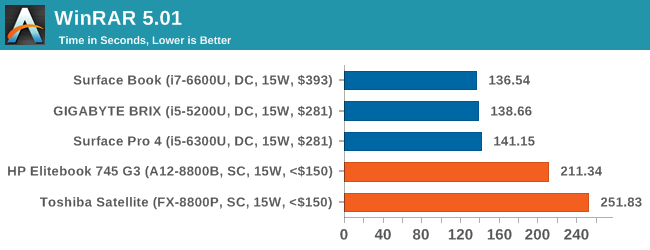

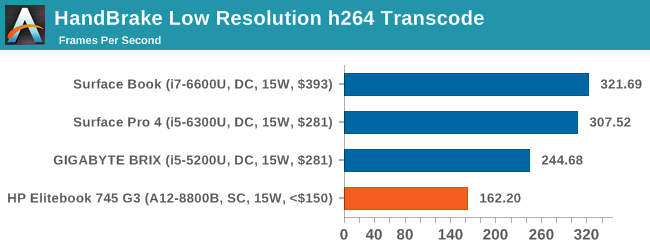

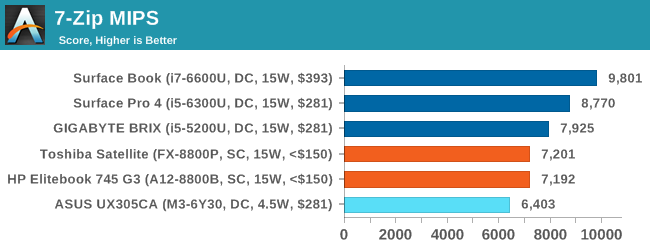
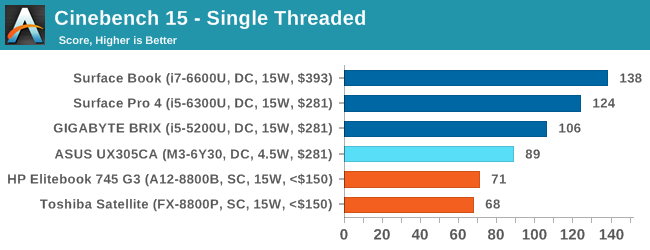
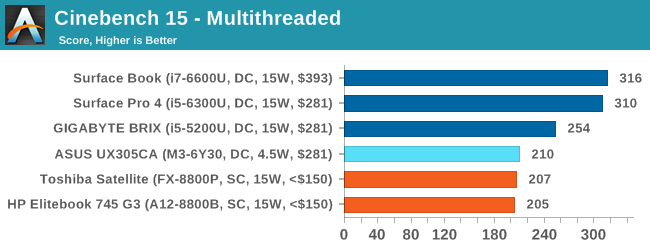
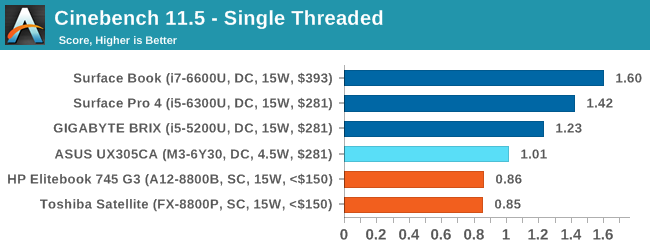


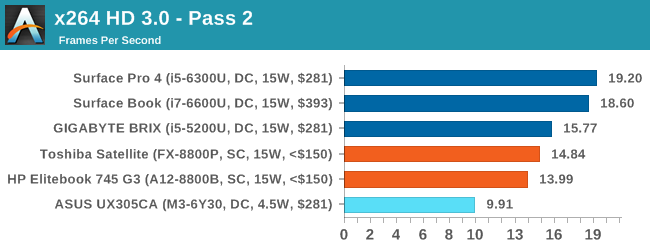
Most tests in this case favor the Intel 15W parts, with only POV-Ray being a fully multi-threaded integer workload pushing over the Broadwell i5-5200U. Ultimately this points to where Carrizo lies in performance: somewhere between Core M and Core i5, and it can sometimes lose to both in single threaded performance.
On the GPU and OpenCL tests:
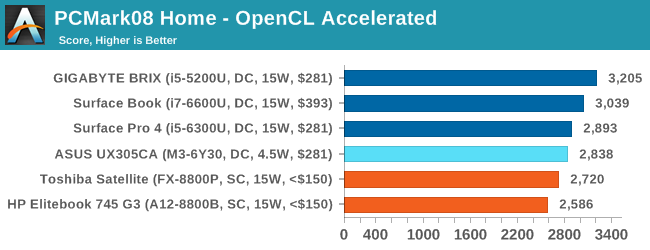
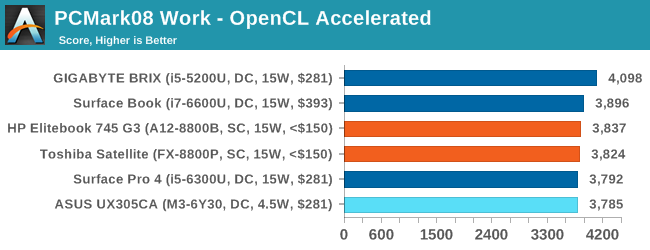

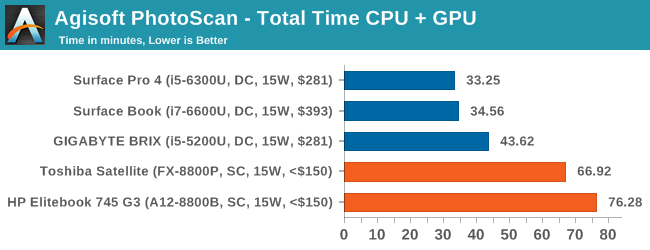
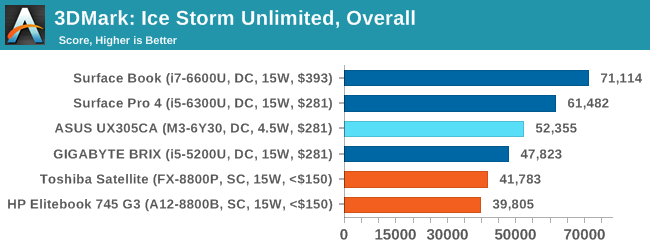

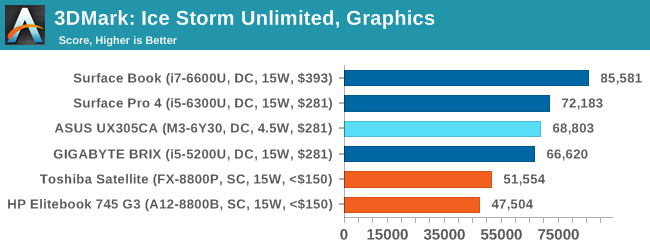

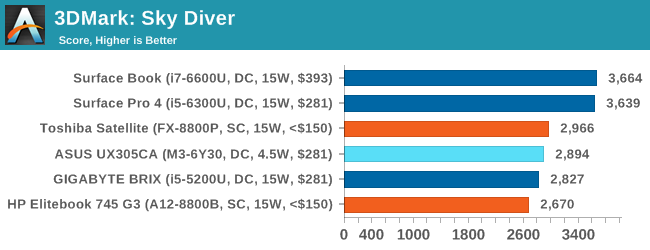
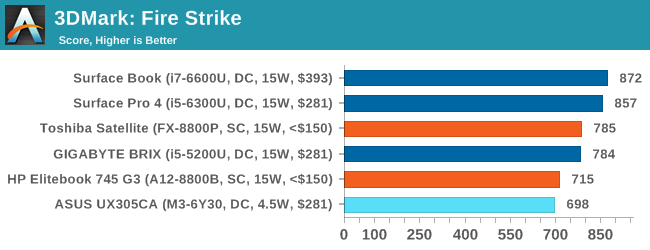
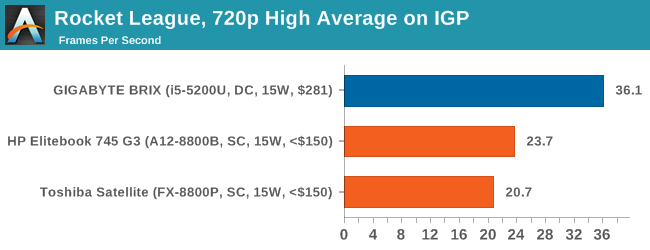
One of AMD’s big pushes is with gaming, OpenCL, and their Heterogeneous System Architecture (HSA). With all three markets, AMD wants to beat Intel. But here we have an issue – both of the AMD parts we have tested here are by default equipped with single channel memory, and may not even be dual channel capable if they share a device design with Carrizo-L (more on this in the next couple of pages). The use of single channel memory when Carrizo systems are sold essentially chokes the key parts of AMD’s offering.
A number of users might think it's unfair to show the results of two single channel Carrizo systems against dual channel Broadwell/Skylake systems, and we totally get that. After speaking internally with other editors however, we came across the situation that many Intel laptops come with dual channel memory as standard or a fixed memory arrangement to begin with. Looking at it closer, there is somewhat of a pattern:
| AMD Carrizo vs Intel Core Current Laptop Designs on the Market |
|||||||
| Name | Lenovo Y700-15ACZ |
HP Elitebook 745 G3 | HP Elitebook 840 G3 | Dell XPS 13 |
ASUS Zenbook UX303 | HP Envy 13t |
|
| Size | 15.6" | 14" | 14" | 13.3" | 13.3" | 13.3" | |
| Resolution | 1080p | 1080p | 1080p | 1080p | 1080p | 1800p | |
| Touch | No | No | No | No | Yes | No | |
| SoC | FX-8800P | A12-8800B | i5-6200U | i5-6200U | i5-6200U | i7-6500U | |
| µArch | Carrizo | Carrizo | Skylake | Skylake | Skylake | Skylake | |
| Integrated GPU | R7 512 SPs |
R7 512 SPs |
HD 520 24 EUs |
HD 520 24 EUs |
HD 520 24 EUs |
HD 520 24 EUs |
|
| Discrete GPU | R9-M380 4GB | - | - | - | - | - | |
| TDP | 35W+? | 15W | 15W | 15W | 15W | 15W | |
| Memory | 1x8GB DDR3L 1600 |
1x4GB DDR3L 1600 |
2x4GB DDR4 2133 |
2x4GB LPDDR3 1866 |
2x4GB DDR3L 1600 |
2x4GB DDR3L 1600 |
|
| Memory Channels |
Single Only |
Single / Dual |
Dual | Dual | Dual | Dual | |
| Storage | 1TB 5400 RPM | 256GB SSD |
128GB SSD |
128GB PCIe | 256GB SSD |
512GB SSD |
|
| Battery Size | 60 Wh | 45.76 Wh > 8.5h |
45.76 Wh | 56 Wh | 50 Wh > 7h |
45.76 Wh > 7.5h |
|
| Weight | 5.72 lbs | 3.41 lb | 3.41 lb | 2.7 lbs | 3.2 lbs | 3 lbs | |
| OS | Win10 Home | Win10/7 Pro |
Win7 Pro |
Win10 Pro | Win10 Home |
Win10 Home | |
| Warranty | 1Yr Base | 3Yr Parts 3Yr Labor |
1Yr Parts 1Yr Labor |
1 Year | 1 Year | 1 Year | |
| Price | £799 / $972 | $1049 | $1149 | $1049 | $899 | $1050 | |
After doing research for that table, there’s a clear relationship between the nature and style of the device. In each circumstance, the default Carrizo arrangement had only single channel memory whereas each Intel device came with dual channel as standard. Part of this is down to cutting costs, while part of it comes to the Carrizo/Carrizo-L shared design in the case of the Lenovo Y700. In each case, the system is being un-necessarily cut off from available performance due to choices at the point of product inception.
With that being said, there are some Intel designs that specifications wise do knock it out of the park. If there’s willing to be compromise a bit on the styling or warranty around this price point, then at the same price as the Elitebook G3 there can be an i7-6500U and a QHD+ display through the HP Envy 13t. But in each other case where the Intel system gets dual channel memory there’s also either a smaller drive or a more restrictive warranty on the Intel system. Or in the case of the Carrizo based Lenovo Y700, under $1000 gets a discrete graphics card, the 35W version of the APU, but it’s still limited to single channel memory by design, which is frustrating.
The situation looks a bit worse if we do a direct comparison between two equivalent price Lenovo Y700 systems:
| AMD Carrizo vs Intel Core Lenovo Ideapad Y700 15.6-inch |
|||
| Name | Lenovo Y700-15ACZ | Lenovo Y700-15 | |
| Visual | |||
| Size | 15.6" 1080p IPS | 15.6" 1080p IPS | |
| Touch | No | No | |
| Processor | AMD FX-8800P (35W) 2M/4T, 2.1-3.4 GHz |
Core i5-6300HQ (45W) 4C/4T, 2.3-3.2 GHz |
|
| Graphics | R6 + R9-M380 4GB | HD 530 + GTX 960M | |
| TDP | 35W + ? | 45W + 65W | |
| Memory | 1 x 8GB DDR3L-1600 Single Channel |
2 x 4GB DDR4-2133 Dual Channel |
|
| Storage | 1 TB 5400 RPM | 500 GB 5400 RPM | |
| Battery | 60 Wh | 60 Wh | |
| WiFi | 'Lenovo AC' | Intel 3165 802.11ac 1x1 | |
| Dimensions | 15.24 x 10.91 x 1.02" | 15.24 x 10.91 x 1.02" | |
| Weight | 5.72 lbs | 5.72 lbs | |
| Webcam | 1280x720 | 1280x720 | |
| OS | Windows 10 Home | Windows 10 Home | |
| Warranty | 1 Year | 1 Year | |
| Price | £799 / $972 | $980 | |
Here are the two Lenovo Y700 models at the same price, one with AMD and the other with Intel. The Intel part has a quad core i5 with a 45W TDP, a GTX 960M for graphics (similar in GFLOPS to the R9 M380) and dual channel memory. The models should compete similarly in gaming at 1080p, but if the AMD system allowed dual channel and CrossFire between the integrated APU and the discrete card it would handily get a boost. DirectX 12 might help here, if it can use both cards depending on the firmware, but at this point the positive for AMD over Intel is the larger hard disk. The Intel model has single stream 802.11ac wireless, which can be upgraded for $20, whereas the AMD wireless is not specified.
There’s no sugar coating the fact that there is a deficit in performance per watt between AMD’s best and Intel’s best in this regard, due to both the architecture and the process node. The price/performance ratio is a little bit trickier to digest, especially when so few AMD designs are by default equipped with enough memory and it can limit the maximum platform performance. In the case of the Y700 above, it’s because the product shares a platform with Carrizo-L making it limited to single channel memory, although I can't exactly find a Carrizo-L APU in a Y700 on the market.
Additional February 10th:
Since the publication of the review, a couple of things have come to our attention. Our pre-production Lenovo Y700, with both memory slots populated, was performing in single channel mode although our source for this sample assumed it was dual channel. Our testing confirmed single channel. However, the full retail version of the Y700 has an updated motherboard design to enable dual channel operation when both memory slots are populated with compatible memory. As far as well can tell, all Carrizo Y700 units at retail should be able to support dual channel memory.


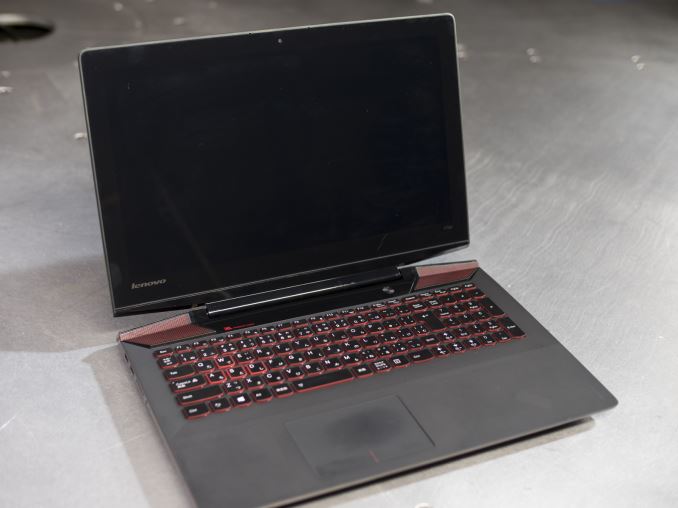
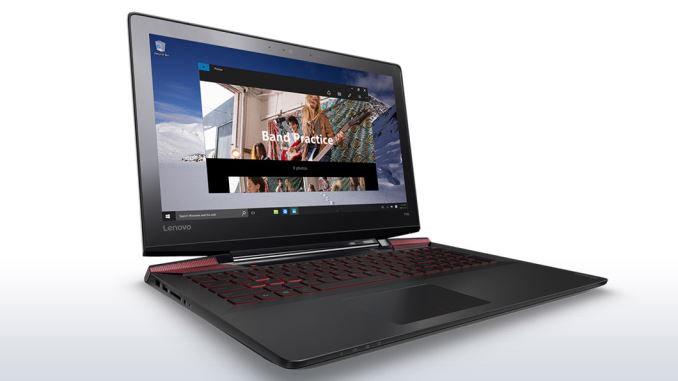








175 Comments
View All Comments
Gadgety - Sunday, February 7, 2016 - link
So AMD's marketing and distribution strategy is a failure. The way it's described it would seem consumers specifying their own PCs would be a away around the dominant logic determined by the existing channels. With today's production technology tailor made products on demand should be possible.The other thing I don't get, is why doesn't AMD release a desktop Carrizo 4K capable APU for the FM2+ platform? Do they want to help the motherboard manufacturers sell more motherboards once the new AM4 socket APU:s are out in 2017, or do they want to sell their own existing products?
JMC2000 - Sunday, February 7, 2016 - link
I think it's more along the lines of having an installed base of AM4 boards before any Zen-based APUs roll out.It is possible that if the Athlon X4 845 sells well, AMD could release a full Carrizo part on FM2+.
AlB80 - Sunday, February 7, 2016 - link
What is discrete graphic chip in Lenovo?512sp GCN1.2.... I suspect that this combination is unreal.
Jamesiii - Sunday, February 7, 2016 - link
I have actually ordered Dell's AMD A8-8600P. It is intended as a media machine with the selling points being the low power equating to quiet and the 4K capability. The one thing I did notice is that he does have the Single Channel DDR3L 1600MHz memory. There is no indication on if it unlocks the watts to 35, but I have my doubts given the choice of RAM.I will know more when I get it on Thursday and will update if anyone is still view this thread. But, at $380.00 it is not a bad choice for a media machine.
tygrus - Sunday, February 7, 2016 - link
OBM (the brands) bid for designs by the ODM's based on the design cost and the expected volume. I high cost Intel design can be made profitable by the expectation of very high volumes. Even the most popular AMD design is expected to sell fewer than a low-volume Intel design. Business limitations and commercial forces bias the system towards Intel. Intel also have deeper pockets to sponsor/partner/subsidise designs to make them Intel exclusive. From manufactures to distributors to retail, Intel penalise (withdraw discounts/subsidies) anyone who lets AMD gain market share (many limited to <10%) and limit the use of the "best" designs for AMD (forced to sell only A4 & A6 instead of A8 or better, limit battery and other features so Intel always looks better). The "Intel brakes" applied to AMD limits their opportunities and potential earnings. This has limited the AMD R&D spending and forced AMD to stay behind in some aspects. It's amazing what AMD has done with 28nm but think of the advantage they could have had with 22nm and 14nm if successful achieved much earlier (no more than 9months after Intel).every1hasaids - Monday, February 8, 2016 - link
I owned (owned being the operative word there) a Y700 with the AMD Carrizo FX8800P and can attest to the fact that the cooling solution and probably several other pieces of that device reviewed in this article are not the same design as what is available on the market in the US. There is a known issue of Lenovo skimping on the VRMs on the AMD Y700 which results in heavy throttling taking place. I couldn't play any game for more than 15 minutes before heavy throttling would occur. The data gathered from the review sample in this article should not be associated with the available product on the market. There appears to also be an FX-8700P variant of the Y700 out there however I cannot find any documentation of the existence of this device on Lenovo's site. Needless to say that I returned that laptop due to the significant throttling problems. I wish this site of some other site could get their hands on one of the FX-8800P Y700 laptops available in the US and put it through testing to reveal the problems with the unit. I'm guessing that they intend on releasing a Carrizo-L version of that laptop with the same motherboard which is why the VRMs are not up to the task of the 35w Carrizo and the added consumption of the dedicated graphics chip.Why are there no units out there that can handle the 35w TDP Carrizo and a dedicated graphics card!?!?!?! It would be a great alternative to the Intel/Nvidia gaming notebook monopoly.
I'm hoping Zen/Polaris will actually see some adoption from OEMs and maybe AMD could even get involved in assisting proper implementation of their products so that the negative stigma could get nullified.
Jamesiii - Monday, February 8, 2016 - link
The FX-8700P would more properly be called an A10-8700P. It sounds like a bit of marketing if they are using the FX handle.On gaming sites people are suggesting you turn off AMD's Turbo Core when gaming to avoid the FPS jumping up and down and overclock the processors. Overclocking a laptop is dicey at best though.
Malih - Monday, February 8, 2016 - link
maybe Microsoft should start making an AMD Surface laptop if they want good competition to drive PC SalesMarcelo Viana - Monday, February 8, 2016 - link
I just don't understand why in a comparison carrizo vs intel you didn't take out the intel chips memory in order to both have 1 channel memory, so do a benchmark for us in a same condition.The entire article show that intel offering has OEMs given what intel chips need, so the point in comparing carrizo vs intel is the chip itself not platform, since AMD has no platform at all.
Elensar286 - Monday, February 8, 2016 - link
That's a large focus of this article, though. The whole point was an investigation in to the implementation of Carrizo APUs by the OEM. It's highlighting exactly how like you said, the OEM platform, is hindering the potential of Carrizo processors.